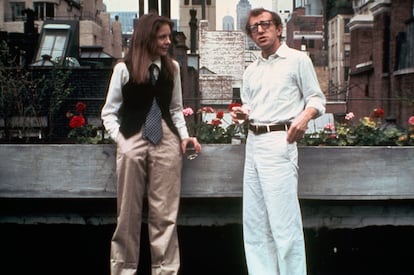How Mel Brooks, Woody Allen and even Kafka exposed the absurd with laughter and wit
Humor is a defining part of Jewish culture, so don’t miss the comedic elements in ‘The Metamorphosis’

I have recently seen two adaptations of The Trial by Franz Kafka. One was an opera by Gottfried von Einem and the other was a play at the María Guerrero Theater in Madrid, directed by Ernesto Caballero with Carlos Hipólito playing Josef K. Neither one gave audiences much to laugh about. I saw the opera in Germany, where laughter may not be the norm, but the cabaret-inspired stage and the dramatic antics of certain singers (mezzo-soprano Patrizia Häusermann as Frau Grubach is a true comedic talent) helped amplify the comedic elements. On the other hand, the Spanish play was expressionistic and austere, which may have led to the misconception that The Trial is a tragedy. Or perhaps the audience was just feeling solemn that night.
I often watch Mel Brooks movies with my 10-year-old son. He’s so used to their style that he bursts into guffaws during the opening credits. When it comes to Brooks, my son believes in laughing non-stop throughout the entire movie. As for Kafka, theater and opera-goers often feel the need to furrow their brows in serious contemplation throughout the performance. Despite their obvious differences, Brooks and Kafka both share a tradition that’s deeply indebted to the same cultural references — Yiddish comedic theater. More and more scholars are now saying that taking Kafka’s work (not all but most) too seriously is terribly misguided.
Jeremy Dauber’s Jewish Comedy: A Serious History is an informative and extensively researched book, drawing on many years of teaching at Columbia University in New York, where it has become a hit with literature students. Dauber compares the castrating and excruciating embarrassment experienced by Gregor Samsa in Kafka’s The Metamorphosis to a relatable example — the opening scene of There’s Something About Mary (1998). Remember young Ben Stiller’s dreadful zipper mishap? Indeed, according to Dauber, Kafka’s humor shares many of the comedic elements found in contemporary cinema.
Many of Kafka’s characters resemble the protagonist of Billy Wilder’s The Apartment (1960) — hapless men trying to maintain their composure in an absurd and hostile system. They also resemble the roguish but appealing heroes of Spanish picaresque novels. Apart from existential themes, Kafka often displays a crude and bawdy sense of humor. Josef K. is much like the sexually repressed men played by Spanish actor Alfredo Landa and the simpletons in cartoons by Forges (Antonio Fraguas de Pablo). They are always bumping into formidable women who leave them feeling utterly powerless. From a traditional perspective of masculinity, these characters are seen as comical because they are emasculated. Their purpose is not to engage the audience in deep reflections on the human condition, but rather to elicit laughter. Dauber, an expert with extensive knowledge gained from a lifetime of study, feels compelled to apologize for equating Kafka’s humor to a spicy comedy. This points out that we may have missed what Jewish readers and those culturally connected to the Czech writer clearly understood.
Dauber wants to explore the connection between Jewish culture and humor, including its religious aspects. He references a 2013 survey by the Pew Research Center which found that 42% of Jewish Americans associate being Jewish with having a sense of humor. Unsurprisingly, this is not so different from the rest of us.
In his book, Dauber suggests that Jewish culture has adopted a human trait that helps us understand the world. As we delve deeper into the nuances of this particular humor, its universality becomes more apparent. Humor can be seen as “the wisdom that allows us to laugh at our fragility,” writes Dauber. This definition reminds us of Carlo Ginzburg, who argues that to truly see things, we must first look at them as if they made no sense. To have a deep understanding of the world, it’s important to embrace a certain level of naiveté. Ginzburg suggests that naiveté (derived from the word native), refers to an untamed and uninformed perspective that allows us to see what the educated cannot because they have grown accustomed to it. Spanish philosopher Javier Gomá calls this “learned ingenuousness.” Humorists like Brooks, Kafka and Woody Allen possess these attributes and use humor to expose the absurdities of the world. In Jewish culture, laughter has played a significant role in preserving their identity as outsiders in gentile societies.
Humor has inspired an extensive body of research that continues to expand — see Terry Eagleton’s Humour (2019), a study of the nature of humor and the functions it serves. However, trying to analyze jokes often leads to dead-end arguments. The more we explain them, the less they are understood. This may be because we see humor as a separate cultural phenomenon, instead of recognizing it as a pervasive trait in human communication across all levels. Sometimes, we treat humorists as a different species from actors, writers and singers, when in fact they simply elevate a deeply human way of living.
Humor transcends time and cultures, but comedic preferences depend on the context. Jokes that once delighted the Romans or the renowned Spanish comedian Arévalo may not elicit the same laughter today. Some people may prefer Sarah Silverman’s monologues, while others may find the humor of Comandante Lara more appealing. While the mechanisms of laughter are universal, no single culture can claim exclusive ownership of them. Interestingly, every region, ethnicity and neighborhood takes pride in their own brand of humor. For example, Jewish Americans embrace their humor-loving identity, while implying that gentiles may not have the same funny bone. It’s not uncommon to hear one tribe tease another for being a bit dull, implying a lack of intelligence. After all, humor often stands as a true indicator of wit.
We have not only designated humor as if it were fine wine, but we have also categorized and professionalized it to the point where it becomes difficult to enjoy it in unexpected places. We view humor as something confined to specific contexts, rather than recognizing it as an inherent aspect of human communication. In contemporary society, high culture has assumed the sacred role traditionally held by religion. Going to the theater now holds the same reverence as attending church, where laughter is seldom expected. Even if the on-stage performance is crude and vulgar, one must maintain composure unless it’s officially classified as comedy, which grants us permission to laugh. From Ginzburg’s viewpoint, this is an amusing paradox — an audience striving to maintain straight faces for the sake of conformity. Just like Gregor Samsa and Josef K.’s futile efforts at feigning solemnity.
Sign up for our weekly newsletter to get more English-language news coverage from EL PAÍS USA Edition
Tu suscripción se está usando en otro dispositivo
¿Quieres añadir otro usuario a tu suscripción?
Si continúas leyendo en este dispositivo, no se podrá leer en el otro.
FlechaTu suscripción se está usando en otro dispositivo y solo puedes acceder a EL PAÍS desde un dispositivo a la vez.
Si quieres compartir tu cuenta, cambia tu suscripción a la modalidad Premium, así podrás añadir otro usuario. Cada uno accederá con su propia cuenta de email, lo que os permitirá personalizar vuestra experiencia en EL PAÍS.
¿Tienes una suscripción de empresa? Accede aquí para contratar más cuentas.
En el caso de no saber quién está usando tu cuenta, te recomendamos cambiar tu contraseña aquí.
Si decides continuar compartiendo tu cuenta, este mensaje se mostrará en tu dispositivo y en el de la otra persona que está usando tu cuenta de forma indefinida, afectando a tu experiencia de lectura. Puedes consultar aquí los términos y condiciones de la suscripción digital.
More information
Archived In
Últimas noticias
Most viewed
- Sinaloa Cartel war is taking its toll on Los Chapitos
- Oona Chaplin: ‘I told James Cameron that I was living in a treehouse and starting a permaculture project with a friend’
- Reinhard Genzel, Nobel laureate in physics: ‘One-minute videos will never give you the truth’
- Why the price of coffee has skyrocketed: from Brazilian plantations to specialty coffee houses
- Silver prices are going crazy: This is what’s fueling the rally











































